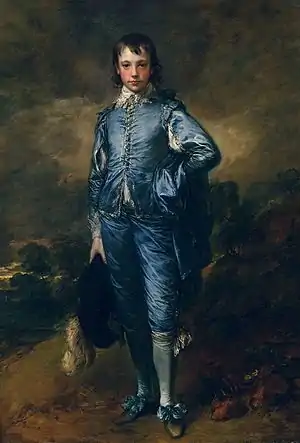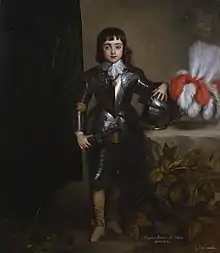The Blue Boy
The Blue Boy (c. 1770) is a full-length portrait in oil by Thomas Gainsborough, now at the Huntington Library, San Marino, California.[2]
| The Blue Boy | |
|---|---|
 | |
| Artist | Thomas Gainsborough |
| Year | c. 1770 |
| Medium | oil on canvas |
| Movement | Rococo |
| Dimensions | 177.8 cm × 112.1 cm (70.0 in × 44.1 in) |
| Location | Henry E. Huntington Art Gallery[1], San Marino, California |
History
Perhaps Gainsborough's most famous work, The Blue Boy is thought to be a portrait of Jonathan Buttle (1752–1805), the son of a wealthy hardware merchant, although this has never been proven. It is a historical costume study as well as a portrait; the painting of the youth in his seventeenth-century apparel is regarded as Gainsborough's homage to Anthony van Dyck and is very similar to Van Dyck's portraits of Charles II as a boy.
Gainsborough had already drawn something on the canvas before beginning The Blue Boy, which he painted over. The painting is about life-size, measuring 48 inches (1,200 mm) wide by 70 inches (1,800 mm) tall. Gainsborough painted the portrait in response to the advice of his rival Sir Joshua Reynolds,[3] who had written:
It ought, in my opinion, to be indispensably observed, that the masses of light in a picture be always of a warm, mellow colour, yellow, red, or a yellowish white, and that the blue, the grey, or the green colours be kept almost entirely out of these masses, and be used only to support or set off these warm colours; and for this purpose, a small proportion of cold colour will be sufficient. Let this conduct be reversed; let the light be cold, and the surrounding colour warm, as we often see in the works of the Roman and Florentine painters, and it will be out of the power of art, even in the hands of Rubens and Titian, to make a picture splendid and harmonious.[3]

The painting was in Buttle's possession until he filed for bankruptcy in 1796. It was first bought by the politician John Nesbitt and then, in 1802, by the portrait painter John Hoppner. In about 1809, The Blue Boy entered the collection of the Earl Grosvenor and remained with his descendants until its sale by the second Duke of Westminster to the dealer Joseph Duveen in 1921.[4] By then, it had become a great popular favourite in print reproductions after having been exhibited to the public in various exhibitions at the British Institution, Royal Academy and elsewhere.
In 1919, the painting inspired German film producer Friedrich Wilhelm Murnau to create his debut film Knabe in Blau (The Boy in Blue).[5]
In a move that caused a public outcry in Britain, it was then sold to the American railway pioneer Henry Edwards Huntington for $728,800 (£182,200), according to Duveen's bill,[6] a then-record price for any painting. According to a mention in The New York Times dated 11 November 1921, the purchase price was $640,000, which would be $9.17 million in 2019.[7]
Before its departure to California in 1922, The Blue Boy was briefly put on display at the National Gallery, where it was seen by 90,000 people; the Gallery's director Charles Holmes was moved to scrawl farewell words on the back of the painting: "Au Revoir, C.H."[8]
The Blue Boy inspired pop artist Robert Rauschenberg to pursue a painting career.[9] It is often paired with a painting by Thomas Lawrence called Pinkie that sits opposite to it at the Huntington Library.
In popular culture
In Quentin Tarantino's film Django Unchained, the main character Django, a freed slave, chooses to wear an outfit identical to that worn by Gainsborough's subject in The Blue Boy.[10]
The painting also is seen in the movie Batman (1989) as hanging in Gotham museum and again in the Joker movie hanging in smaller form in the Joker’s apartment.
References
Citations
- Children's Encyclopædia Britannica. 8. London. 1969. p. 12; see plate.
- "Jonathan Buttal: The Blue Boy (c 1770)". The Huntington Library. Archived from the original on 19 June 2010. Retrieved 7 December 2009.
- Gower, Ronald Sutherland (1903). Thomas Gainsborough. G. Bell and Sons. pp. 77–78. Retrieved 2 October 2012 – via Google Books.
- "Duveens offer a Reynolds to Louvre". New York Times. 19 October 1921.
- Bock, Hans-Michael (2009). Hans-Michael Bock, Tim Bergfelder (ed.). The concise Cinegraph: encyclopaedia of German cinema. Berghahn Books. p. 334. ISBN 978-1-57181-655-9.
- Thorpe, James Ernest, Henry Edwards Huntington, A Biography, Berkeley: University of California Press, 1994, p. 438.
- "WolframAlpha conversion".
- "'Blue Boy's' Transfer Begins in Secrecy" (PDF). The New York Times. 26 January 1922. Retrieved 7 December 2009.
- Tuchman, Phyllis (16 May 2008). "The Invincible Robert Rauschenberg". Obit Magazine. Retrieved 6 December 2009.
- "Sharen Davis Costume Interview: Django Unchained". Clothes on Film. 1 January 2013. Retrieved 11 January 2021.
Further reading
- Conisbee, Philip (2003). "The Ones That Got Away". In Verdi, Richard (ed.). Saved! 100 Years of the National Art Collection Fund. London: Scala.
- Conlin, Jonathan (2006). The Nation's Mantelpiece: A history of the National Gallery. London: Pallas Athene.
- Thicknesse, Philip (1790). Life of Sir Thomas Gainsborough.
- Tyler, David (2004). "Jonathan Buttall". Oxford Dictionary of National Biography. Oxford: Oxford University Press.
See also
External links
![]() Media related to The Blue Boy at Wikimedia Commons
Media related to The Blue Boy at Wikimedia Commons